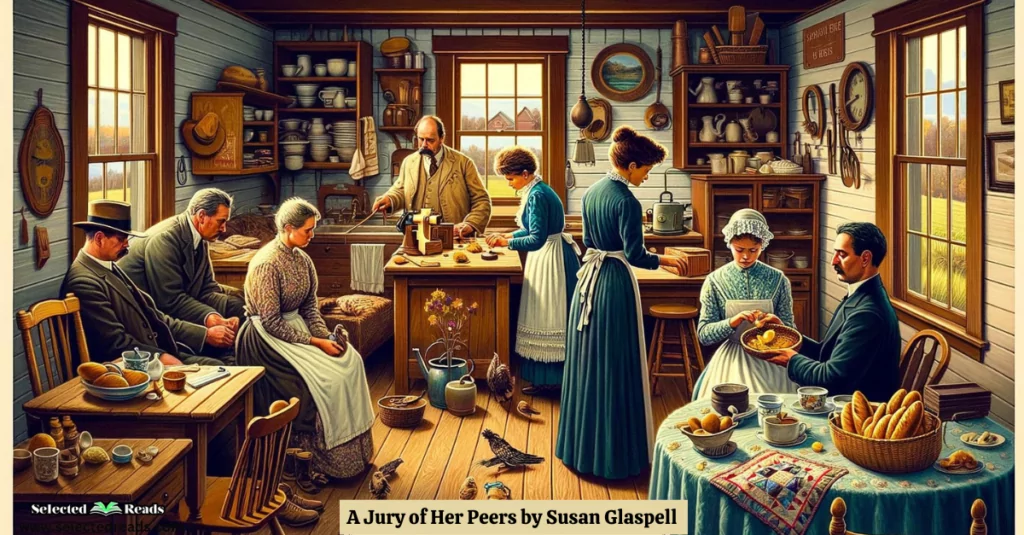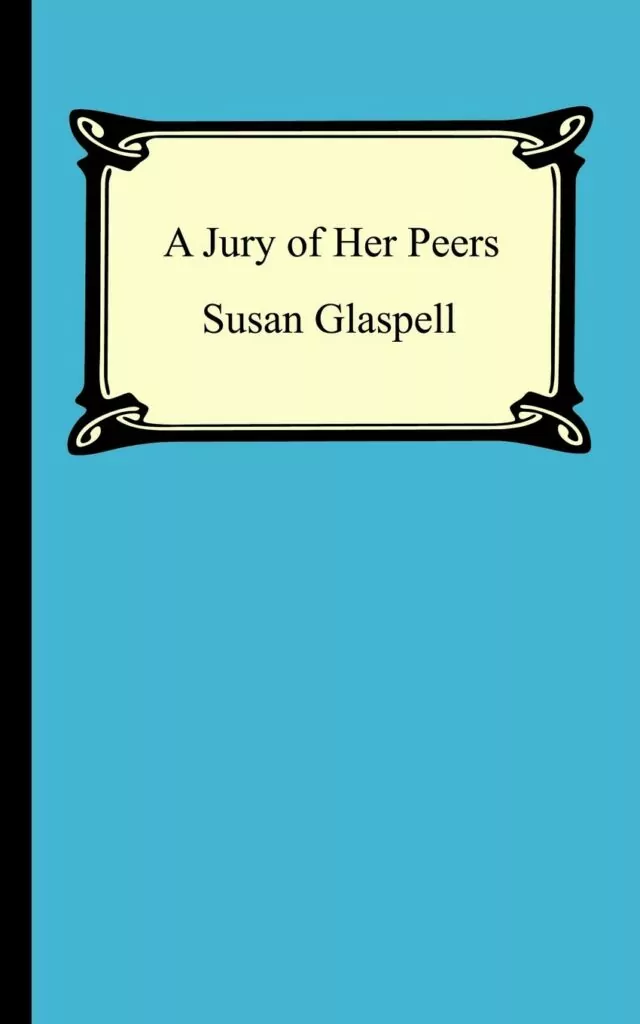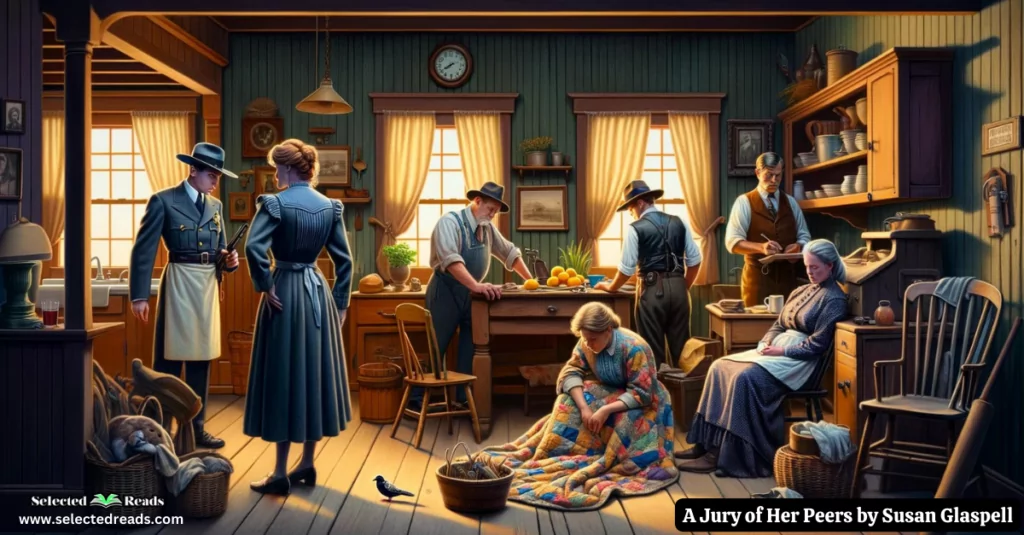Susan Glaspell’s “A Jury of Her Peers” is a wonderful piece of literary treasure that, despite being written in the early 20th century, resonates with timeless themes of gender, justice, and the intricate dynamics of human relationships. The book invites us into a world where the unspoken and overlooked carry weighty truths.
The purpose of today’s post is to introduce you to the literary of world of Susan Glaspell through an extensive discussion of her work A Jury of Her Peers. We will proceed as follows: First, we provide extended summary of the book discussing its plot, the undercurrents of its themes, and the subtleties of its character dynamics.
Following the summary, we’ll introduce the key characters of the narrative. Each character, from the main protagonists, Mrs. Hale and Mrs. Peters, to the more peripheral figures, plays a pivotal role in unfolding the narrative’s complexities.
Lastly, we’ll propose a set of book club questions. These questions are designed to spark conversation and reflection, encouraging readers to engage with the text on a deeper level. Whether you’re discussing “A Jury of Her Peers” in a classroom setting, among a group of book enthusiasts, or simply pondering its themes solo, these questions aim to facilitate a rich exploration of the story’s many layers.
Through this journey, we aim not just to analyze a piece of literature, but to connect with it, drawing parallels between Glaspell’s world and our own. In doing so, we continue the conversation about the evolution of societal roles, the nature of justice, and the power of empathy—themes as relevant today as they were a century ago.
A Jury of Her Peers Summary
“A Jury of Her Peers” by Susan Glaspell is a riveting short story that delves deep into themes of gender roles, justice, and the complexities of human relationships. It’s a narrative that speaks volumes, especially when viewed through the lens of its early 20th-century setting, yet its themes remain strikingly relevant today.
The story is set in rural America and begins with the arrest of John Wright for murder. The local sheriff, accompanied by the county attorney and a neighboring farmer, George Henderson, visits Wright’s farmhouse to collect evidence for the trial. They bring along Mrs. Hale and Mrs. Peters, the wives of the farmer and the sheriff, respectively, under the assumption that they might collect some household items for Mrs. Wright, who is now in custody.
As the men go about their official investigation, scoffing at the domestic sphere they see as irrelevant to their legal pursuits, the women start to piece together the real story. Through subtle observations of the Wright household, they notice signs of a deeply unhappy marriage. The kitchen, the heart of the home, tells tales of unfinished work, a bread mix left out, and a dirty towel—trivial to the men but significant to the women. Most telling is the discovery of Mrs. Wright’s canary, with its neck wrung, hidden in a beautifully stitched quilt.
Photo: Amazon
The women, Mrs. Hale and Mrs. Peters, realize that the canary, likely a source of solace and joy for Mrs. Wright in her lonely, oppressive marriage, was killed by Mr. Wright. This act, they infer, might have driven Mrs. Wright to murder her husband. Yet, the men, focused on tangible evidence, remain oblivious to these clues and the motive behind the murder.
Glaspell uses the narrative to critique the patriarchal justice system of the time, which overlooked women’s experiences and devalued their insights. The women, understanding the unspoken and unseen, enact their own form of justice by choosing to protect Mrs. Wright, effectively becoming her jury. They hide the evidence that could condemn her, recognizing that the legal system might not fairly judge her actions given the context of her life.
This story, based on a real case Glaspell reported on as a young journalist, is a poignant commentary on the isolation and oppression women faced, and how, in a world where their voices were marginalized, they found ways to communicate and support each other. It’s a testament to the strength found in shared experiences and the silent language of empathy and understanding that can transcend the spoken word.
A Jury of Her Peers Characters
In “A Jury of Her Peers” by Susan Glaspell, the narrative revolves around a select group of characters, each contributing to the unfolding mystery and thematic depth of the story. The main characters are as follows:
- Mrs. Martha Hale: A central character, Mrs. Hale is the wife of a local farmer. She is brought along to the Wright household under the pretext of gathering some items for Mrs. Wright, who is in custody. As the story unfolds, Mrs. Hale’s observations and reflections provide key insights into the life of Mrs. Wright and the dynamics of her household. Mrs. Hale’s deep sense of empathy and understanding of the domestic sphere play a crucial role in the narrative.
- Mrs. Minnie Wright (née Foster): Although Mrs. Wright does not appear directly in the story, her presence is palpable throughout. She is the wife of John Wright and is suspected of murdering him. The story gradually reveals aspects of her life, personality, and the possible motives behind her actions through the eyes of Mrs. Hale and Mrs. Peters.
- Mrs. Peters: The wife of the sheriff, Mrs. Peters initially seems to adhere more strictly to the societal norms of the time. However, as the story progresses, she develops a profound connection with Mrs. Wright’s plight, demonstrating growth in empathy and moral courage. Her transformation is a significant element of the story’s development.
- John Wright: The murdered husband of Minnie Wright, John Wright is depicted posthumously through the accounts of other characters. His portrayal suggests a hard, cold man who may have been emotionally (and possibly physically) abusive to his wife, contributing to the story’s examination of the dark aspects of human relationships.
- Mr. Lewis Hale: Mr. Hale is a neighboring farmer who discovered John Wright’s body. His recounting of the events leading to the discovery provides the initial framework for the narrative. Although his role is more peripheral, his perspective adds to the contrasting views between male and female characters in the story.
- Sheriff Peters: The sheriff is responsible for the investigation of John Wright’s murder. His character, along with the county attorney, represents the official law enforcement perspective, focusing on tangible evidence and overlooking the domestic details that ultimately reveal the motive and truth behind the murder.
- George Henderson (County Attorney): Henderson is the county attorney tasked with building the case against Minnie Wright. His dismissive attitude toward the women and the domestic sphere they inhabit highlights the gender biases of the time and serves as a foil to the intuitive understanding demonstrated by Mrs. Hale and Mrs. Peters.
A Jury of Her Peers Book Club Questions
Here are several questions designed to delve into the themes, characters, and narrative techniques Glaspell employs, ensuring a stimulating conversation:
- Exploration of Gender Roles: How do the gender roles depicted in the story reflect the societal attitudes of the early 20th century? In what ways do Mrs. Hale and Mrs. Peters subvert these roles, and what does that suggest about their character development?
- Justice and Morality: The story presents a complex view of justice and morality. Discuss whether you believe Mrs. Hale and Mrs. Peters made the right decision by concealing the evidence. How does this action challenge or support your understanding of justice?
- Symbolism: Glaspell uses various symbols throughout the story (e.g., the canary, the quilt). Choose one symbol and discuss its significance. How does it contribute to the story’s themes or character development?
- Setting as Character: How does the setting of the story (a rural farmhouse) influence the narrative? Consider how the isolation and domestic environment contribute to our understanding of Mrs. Wright’s situation and the unfolding mystery.
- Comparative Analysis: How do the perspectives of the men and women in the story differ in their approach to solving the murder? What does this say about the value of domestic work and emotional labor?
- Historical Context: Considering the story was published in 1917, discuss how it reflects the social and cultural issues of the time. How might the story be different if it were set in today’s world?
- Empathy and Understanding: The story hinges on the empathy Mrs. Hale and Mrs. Peters feel for Mrs. Wright. Discuss moments in the story where empathy leads to action. Have you ever experienced a moment where empathy led you to see a situation differently?
- The Unspoken Language: Much of the communication between Mrs. Hale and Mrs. Peters is non-verbal. How does Glaspell use these moments to build tension and convey complex emotions? What does this suggest about the power of unspoken understanding between individuals?
- Critical Reception and Legacy: “A Jury of Her Peers” is based on Glaspell’s 1916 play, “Trifles.” Discuss why you think Glaspell chose to adapt the play into a short story. What might this shift in medium offer in terms of narrative technique or audience reach?
- Personal Reflection: Was there a particular moment or aspect of the story that resonated with you personally? How does Glaspell’s story encourage us to reflect on our own views of gender, justice, and empathy?
Final thoughts
In wrapping up our exploration of Susan Glaspell’s “A Jury of Her Peers,” we’ve traversed through the intricate landscape of gender dynamics, justice, empathy, and the power of silent understanding. This story, though set in the early 20th century, transcends its era to speak to the enduring human conditions of isolation, oppression, and the quest for understanding. Through the detailed summary, character analysis, and thought-provoking book club questions, we’ve delved deep into the layers of Glaspell’s narrative, uncovering the richness and complexity of her work.









